Still no yellow brick road for uranium
Paladin Energy says it is ready to restart the Langer Heinrich mine, but only at the right uranium price and if the company secures favourable term contracts.
Jo-Maré Duddy – Paladin Energy, the majority shareholder in Langer Heinrich, at the end of June said it needed US$81 million or around N$1.4 billion to restart the local uranium mine.
The mine ceased production in May 2018 due to the persistent low uranium price. More than 300 workers were retrenched when Langer Heinrich was put on care and maintenance.
Paladin, an Australian-based global uranium miner, owns 75% of Langer Heinrich, while CNNC Overseas Uranium Holding Limited, a wholly-owned subsidiary of China National Nuclear Corporation (CNNC), has the rest.
In an announcement on the Namibian Stock Exchange (NSX) and Australian bourse (ASX) where Paladin is listed, the company last month said its restart plan is completed and “marks the completion of an extensive work package aimed at delivering a reliable mine restart to bring the globally significant Langer Heinrich Mine back into production under the right uranium pricing environment”.
When Paladin’s board in February last year approved a prefeasibility study to restart Langer Heinrich, it said the mine could be back in full swing as early as the middle of 2021 should the uranium price recovered.
In its latest announcement, such indications are absent.
Price
“Given the commercially sensitive and confidential nature of the company’s ongoing discussions with potential customers, the company will not be providing guidance on the hurdle price required to support a decision to restart the Langer Heinrich Mine,” Paladin said.
It added that the current spot pricing of around US$34 per pound and term pricing of about US$39 per pound as reported by TradeTech “would not deliver the economic returns required for the company to restart the Langer Heinrich Mine”.
However, Paladin remains poised to take advantage of the growing structural uranium supply deficit in global markets, the company said.
“Spot prices have increased by 36% since the start of January 2020 to approximately US$34/lb U3O8. The company notes continued primary production cuts and US utility contract coverage reaching critical lows,” Paladin continued.
In its latest quarterly bulletin released in June, the Bank of Namibia (BoN) said the spot price of uranium declined on a yearly basis, while it increased on a quarterly basis in the first quarter of 2020.
“The yearly decline in the uranium price by 6.6% to an average of U$25.59 per pound in the first quarter of 2020 was due to global excess supply of the metal,” the central bank said.
On a quarterly basis, the price increased by 2.1%.
The BoN attributed this to the Canadian Mining and Energy Corporation’s (Cameco) decision to close the Cigar Lake mine, which produces about 13% of the global uranium supply. Further, Cameco’s decision to shut down some of its operations at the Port Hope fuel service facility in March 2020 also contributed to the increase in uranium price.
“In addition, Kazatomprom, the largest uranium producer, also announced that it was reducing operational activities at its uranium mines in Kazakhstan for about three months,” the BoN added.
According to the BoN, spot uranium prices rose further to an average of US$34.25 per pound in May 2020 as the market responded to the reductions in supply.
Buyers
Besides the right price, Paladin also needs sufficient term contracts.
Langer Heinrich currently has a life of mine uranium offtake with CNNC Overseas Uranium Holding Limited, Paladin said in its recent announcement.
“The offtake is for up to 25% of future production at approximately the then prevailing uranium spot price. The details of the offtake agreement are commercially sensitive and confidential,” Paladin said.
The restart of Langer Heinrich Mine will only be considered on the company securing additional term contracts with sufficient tenor and value to underpin an appropriate return to all stakeholders, Paladin emphasised.
“The tenor, structure and pricing of the proposed term contracts are subject to bilateral negotiations with potential customers and are commercially sensitive and confidential,” it added.
Paladin, however, maintain that Langer Heinrich “remains competitively positioned versus other suspended mines, highlighted through modest restart capital and competitive operating costs, further underpinned by a proven product quality and a globally significant operation with lower incentive prices than greenfield projects”.
Figures
Paladin said it “remains in a healthy financial position”.
This includes US$35 million in cash at the end of May this year, a “significant runway to execute” its strategy. Paladin further said it has a “greatly reduced cash burn” for its 2021 financial year with a cash spend forecast of less than US$10 million. At the end of May, Paladin also had US$145 million of senior debt repayable in January 2023.
The US$81 million pre-production cash expenditure to restart Langer Heinrich will be spent as follow: US$34 million for operational readiness “required to mobilise the work force, undertake maintenance and provide the working capital requirements to commence production”, as well as discretionary capital of US$47 million “specifically aimed at improving process plant availability and reliability to lift production capacity by more than 10%”.
Paladin said the restart plan has confirmed a 17-year mine life for Langer Heinrich with peak production of 5.9 million pounds of U3O8 (triuranium octoxide or yellowcake) per year for seven years.
The life of mine plan outlines three distinct operational phases, Paladin said: Year 1 for ramp-up, years 2 to 8 for mining and years 9 to 17 for stockpiling.
Paladin CEO, Ian Purdy said: “The completion of the Langer Heinrich Mine Restart Plan is a significant step forward for the company and completes the vast amount of study work undertaken over the past 18 months.
“The operational and economic parameters identified in the chosen restart plan show the strategic significance of the Langer Heinrich asset and highlight the potential economic returns that can be delivered under the right uranium price environment.”
Namibia
Even before the onslaught of Covid-19, economic analysts Cirrus Securities had their reservations about a rosier outlook for uranium this year.
In Cirrus’ economic outlook for 2020, released in January, the analysts still expected uranium output in Namibia to grow by 17.5% this year given the low growth base of -4.4% in 2019.
In its economic outlook update in April 2019, the BoN anticipated growth of 14.2% for uranium in 2020. A year later, the central bank expects growth of -22.4%.
“The uranium mining sector is anticipated to post a poor performance during 2020, largely due to water supply constraints. Other factors affecting the sector include persistently low international price for uranium and Covid-19 induced restrictions that are expected to negatively impact shipping logistics,” the BoN said in its economic outlook update in April 2020.
According to BoN stats, Namibia in the first quarter of this year produced less uranium both year-on-year (y-o-y) and quarter-on-quarter (q-o-q) as a result of water supply constraints.
“Uranium production declined significantly by 26.3% and 32.8% both y-o-y and q-o-q, respectively, to 1 181 tonnes in the first quarter of 2020,” the latest quarterly bulletin states.
Export earnings from uranium equally nosedived both on an annual and quarterly basis during the first three months of 2020, “largely due to lower volumes of uranium exported owing to logistical challenges”.
Export earnings from uranium fell by 72% and 78% to N$645 million, y-o-y and q-o-q, respectively, the BoN said. Logistical delays at ports owing to the Covid-19 pandemic resulted in only 428 tonnes exported, a drop of 73.8% y-o-y and by 77.7% q-o-q.
“The annual and quarterly developments were explained by logistical and supply chains challenges as a result of the measures imposed to mitigate the spread of the Covid-19 pandemic, aggravated by weak global demand and limited supply,” the BoN said.
Cirrus said spot prices for uranium remain depressed, well below profitable levels for Namibia’s mines.
“While global nuclear organisations talk about recovery, this is a very long-term outlook – over the 10-20 years. We do not foresee a short-term recovery,” Cirrus said.
The mine ceased production in May 2018 due to the persistent low uranium price. More than 300 workers were retrenched when Langer Heinrich was put on care and maintenance.
Paladin, an Australian-based global uranium miner, owns 75% of Langer Heinrich, while CNNC Overseas Uranium Holding Limited, a wholly-owned subsidiary of China National Nuclear Corporation (CNNC), has the rest.
In an announcement on the Namibian Stock Exchange (NSX) and Australian bourse (ASX) where Paladin is listed, the company last month said its restart plan is completed and “marks the completion of an extensive work package aimed at delivering a reliable mine restart to bring the globally significant Langer Heinrich Mine back into production under the right uranium pricing environment”.
When Paladin’s board in February last year approved a prefeasibility study to restart Langer Heinrich, it said the mine could be back in full swing as early as the middle of 2021 should the uranium price recovered.
In its latest announcement, such indications are absent.
Price
“Given the commercially sensitive and confidential nature of the company’s ongoing discussions with potential customers, the company will not be providing guidance on the hurdle price required to support a decision to restart the Langer Heinrich Mine,” Paladin said.
It added that the current spot pricing of around US$34 per pound and term pricing of about US$39 per pound as reported by TradeTech “would not deliver the economic returns required for the company to restart the Langer Heinrich Mine”.
However, Paladin remains poised to take advantage of the growing structural uranium supply deficit in global markets, the company said.
“Spot prices have increased by 36% since the start of January 2020 to approximately US$34/lb U3O8. The company notes continued primary production cuts and US utility contract coverage reaching critical lows,” Paladin continued.
In its latest quarterly bulletin released in June, the Bank of Namibia (BoN) said the spot price of uranium declined on a yearly basis, while it increased on a quarterly basis in the first quarter of 2020.
“The yearly decline in the uranium price by 6.6% to an average of U$25.59 per pound in the first quarter of 2020 was due to global excess supply of the metal,” the central bank said.
On a quarterly basis, the price increased by 2.1%.
The BoN attributed this to the Canadian Mining and Energy Corporation’s (Cameco) decision to close the Cigar Lake mine, which produces about 13% of the global uranium supply. Further, Cameco’s decision to shut down some of its operations at the Port Hope fuel service facility in March 2020 also contributed to the increase in uranium price.
“In addition, Kazatomprom, the largest uranium producer, also announced that it was reducing operational activities at its uranium mines in Kazakhstan for about three months,” the BoN added.
According to the BoN, spot uranium prices rose further to an average of US$34.25 per pound in May 2020 as the market responded to the reductions in supply.
Buyers
Besides the right price, Paladin also needs sufficient term contracts.
Langer Heinrich currently has a life of mine uranium offtake with CNNC Overseas Uranium Holding Limited, Paladin said in its recent announcement.
“The offtake is for up to 25% of future production at approximately the then prevailing uranium spot price. The details of the offtake agreement are commercially sensitive and confidential,” Paladin said.
The restart of Langer Heinrich Mine will only be considered on the company securing additional term contracts with sufficient tenor and value to underpin an appropriate return to all stakeholders, Paladin emphasised.
“The tenor, structure and pricing of the proposed term contracts are subject to bilateral negotiations with potential customers and are commercially sensitive and confidential,” it added.
Paladin, however, maintain that Langer Heinrich “remains competitively positioned versus other suspended mines, highlighted through modest restart capital and competitive operating costs, further underpinned by a proven product quality and a globally significant operation with lower incentive prices than greenfield projects”.
Figures
Paladin said it “remains in a healthy financial position”.
This includes US$35 million in cash at the end of May this year, a “significant runway to execute” its strategy. Paladin further said it has a “greatly reduced cash burn” for its 2021 financial year with a cash spend forecast of less than US$10 million. At the end of May, Paladin also had US$145 million of senior debt repayable in January 2023.
The US$81 million pre-production cash expenditure to restart Langer Heinrich will be spent as follow: US$34 million for operational readiness “required to mobilise the work force, undertake maintenance and provide the working capital requirements to commence production”, as well as discretionary capital of US$47 million “specifically aimed at improving process plant availability and reliability to lift production capacity by more than 10%”.
Paladin said the restart plan has confirmed a 17-year mine life for Langer Heinrich with peak production of 5.9 million pounds of U3O8 (triuranium octoxide or yellowcake) per year for seven years.
The life of mine plan outlines three distinct operational phases, Paladin said: Year 1 for ramp-up, years 2 to 8 for mining and years 9 to 17 for stockpiling.
Paladin CEO, Ian Purdy said: “The completion of the Langer Heinrich Mine Restart Plan is a significant step forward for the company and completes the vast amount of study work undertaken over the past 18 months.
“The operational and economic parameters identified in the chosen restart plan show the strategic significance of the Langer Heinrich asset and highlight the potential economic returns that can be delivered under the right uranium price environment.”
Namibia
Even before the onslaught of Covid-19, economic analysts Cirrus Securities had their reservations about a rosier outlook for uranium this year.
In Cirrus’ economic outlook for 2020, released in January, the analysts still expected uranium output in Namibia to grow by 17.5% this year given the low growth base of -4.4% in 2019.
In its economic outlook update in April 2019, the BoN anticipated growth of 14.2% for uranium in 2020. A year later, the central bank expects growth of -22.4%.
“The uranium mining sector is anticipated to post a poor performance during 2020, largely due to water supply constraints. Other factors affecting the sector include persistently low international price for uranium and Covid-19 induced restrictions that are expected to negatively impact shipping logistics,” the BoN said in its economic outlook update in April 2020.
According to BoN stats, Namibia in the first quarter of this year produced less uranium both year-on-year (y-o-y) and quarter-on-quarter (q-o-q) as a result of water supply constraints.
“Uranium production declined significantly by 26.3% and 32.8% both y-o-y and q-o-q, respectively, to 1 181 tonnes in the first quarter of 2020,” the latest quarterly bulletin states.
Export earnings from uranium equally nosedived both on an annual and quarterly basis during the first three months of 2020, “largely due to lower volumes of uranium exported owing to logistical challenges”.
Export earnings from uranium fell by 72% and 78% to N$645 million, y-o-y and q-o-q, respectively, the BoN said. Logistical delays at ports owing to the Covid-19 pandemic resulted in only 428 tonnes exported, a drop of 73.8% y-o-y and by 77.7% q-o-q.
“The annual and quarterly developments were explained by logistical and supply chains challenges as a result of the measures imposed to mitigate the spread of the Covid-19 pandemic, aggravated by weak global demand and limited supply,” the BoN said.
Cirrus said spot prices for uranium remain depressed, well below profitable levels for Namibia’s mines.
“While global nuclear organisations talk about recovery, this is a very long-term outlook – over the 10-20 years. We do not foresee a short-term recovery,” Cirrus said.


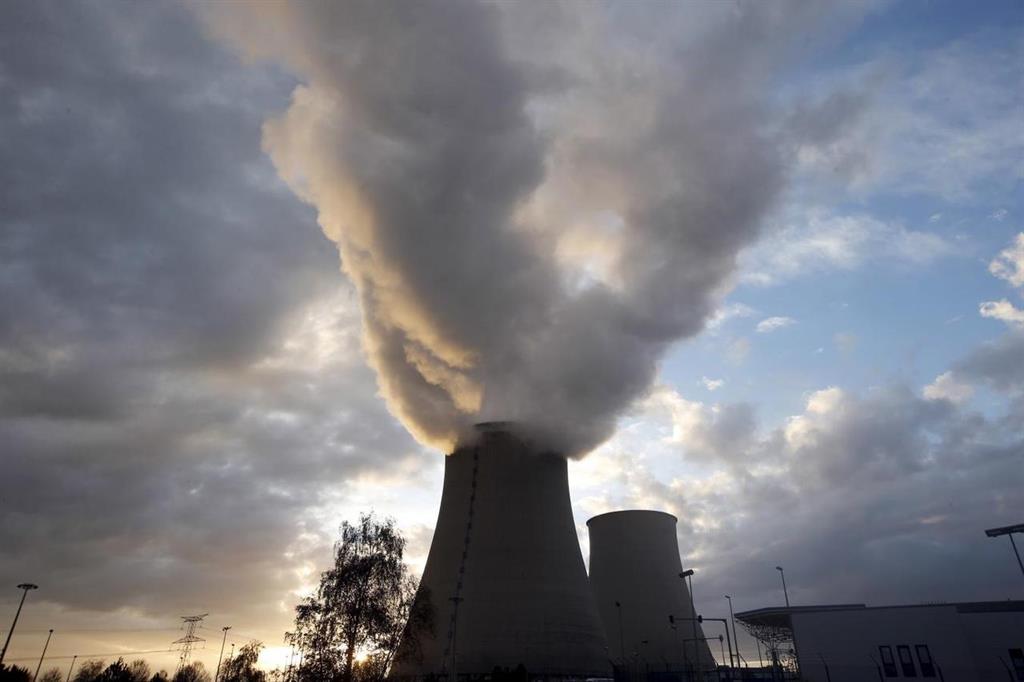
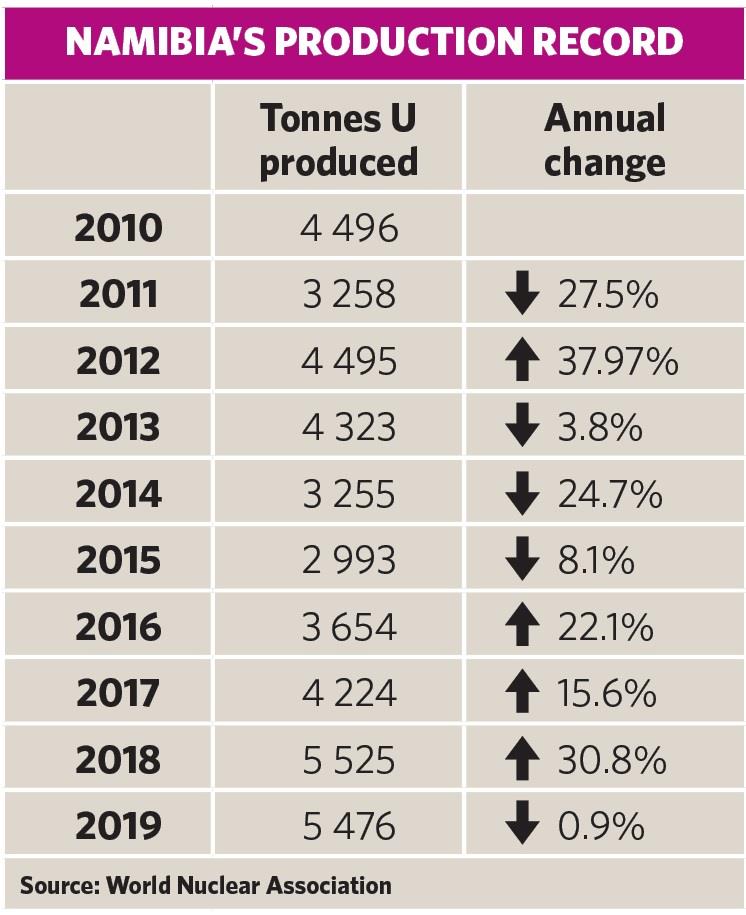
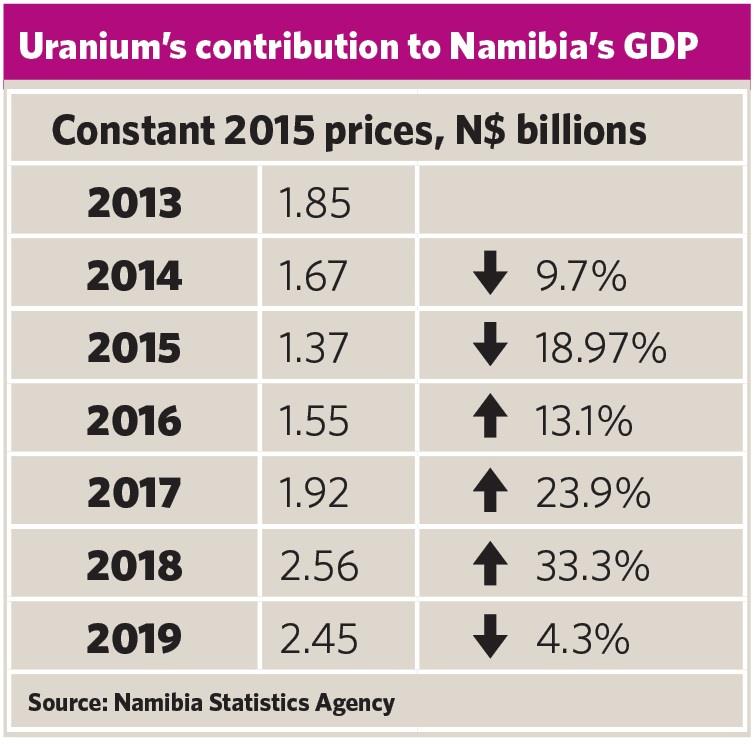
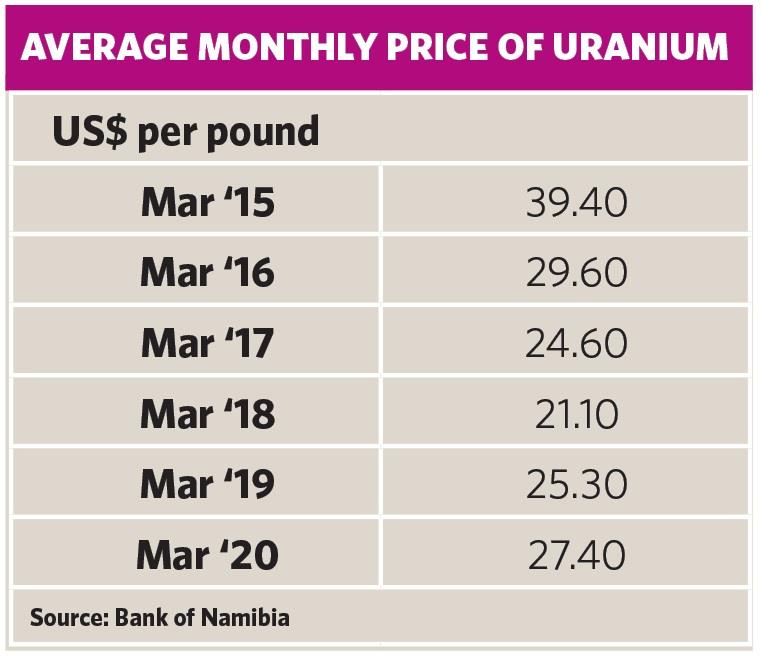
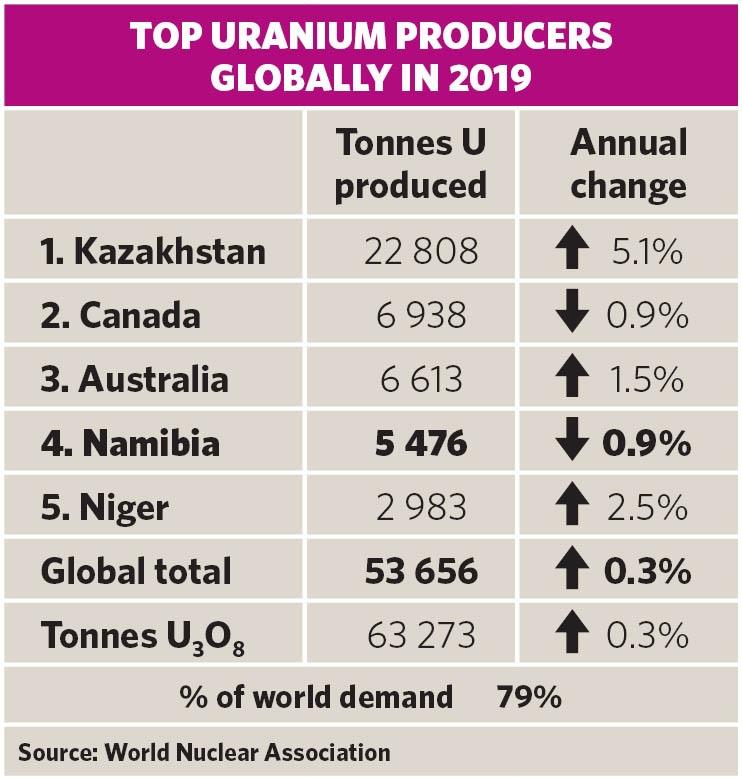

Kommentaar
Republikein
Geen kommentaar is op hierdie artikel gelaat nie